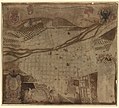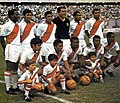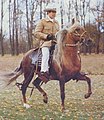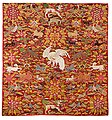Portal:Peru
Introduction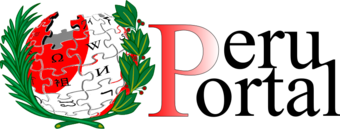
Peru, officially the Republic of Peru, is a country in western South America. It is bordered in the north by Ecuador and Colombia, in the east by Brazil, in the southeast by Bolivia, in the south by Chile, and in the south and west by the Pacific Ocean. Peru is a megadiverse country with habitats ranging from the arid plains of the Pacific coastal region in the west to the peaks of the Andes mountains extending from the north to the southeast of the country to the tropical Amazon basin rainforest in the east with the Amazon River. Peru has a population of over 32 million, and its capital and largest city is Lima. At 1,285,216 km2 (496,225 sq mi), Peru is the 19th largest country in the world, and the third largest in South America. Peruvian territory was home to several cultures during the ancient and medieval periods, and has one of the longest histories of civilization of any country, tracing its heritage back to the 10th millennium BCE. Notable pre-colonial cultures and civilizations include the Caral–Supe civilization (the earliest civilization in the Americas and considered one of the cradles of civilization), the Nazca culture, the Wari and Tiwanaku empires, the Kingdom of Cusco, and the Inca Empire, the largest known state in the pre-Columbian Americas. The Spanish Empire conquered the region in the 16th century and Charles V established a viceroyalty with the official name of the Kingdom of Peru that encompassed most of its South American territories, with its capital in Lima. Higher education started in the Americas with the official establishment of the National University of San Marcos in Lima in 1551. Peru's population includes Mestizos, Amerindians, Europeans, Africans and Asians. The main spoken language is Spanish, although a significant number of Peruvians speak Quechuan languages, Aymara, or other Indigenous languages. This mixture of cultural traditions has resulted in a wide diversity of expressions in fields such as art, cuisine, literature, and music. (Full article...) Entries here consist of Good and Featured articles, which meet a core set of high editorial standards.
LANSA Flight 502 was a Lockheed L-188A Electra operated by Líneas Aéreas Nacionales Sociedad Anónima (LANSA) which crashed shortly after takeoff from Quispiquilla Airport near Cusco, Peru, on August 9, 1970, after losing all power from one of its four engines. The turboprop airliner, registered OB-R-939, was bound from Cusco to Lima, carrying 8 crew and 92 passengers. All but one of the occupants died from injuries sustained from impact forces and post crash fire. Two people on the ground were also killed. There were 49 American high school exchange students on board, all of whom perished. A Peruvian government investigation concluded that the accident was caused by improper execution of engine-out procedures by the flight crew and lack of proper maintenance. LANSA was fined and its operations were suspended for 90 days. At the time, the crash was the deadliest ever in Peruvian history before being surpassed by Faucett Perú Flight 251 in 1996. (Full article...) Selected image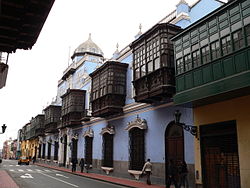 Photo credit: Manuel González Olaechea
Osambela House (Spanish: Casa de Osambela) is one of the biggest houses built in Lima during the colonial period. This mansion was built between 1803 and 1805, but was officially finished in 1807. It has five balconies and a mirador from which the first owner of the place, Don Martín de Osambela, watched with a spyglass the arrival of galleons to the port of Callao. It was renovated in 2003 and serves as a venue for art exhibitions and cultural events. (more...) Selected battleThe Battle of Arica, also known as Assault and capture of Arica Cape, is a belic action of the War of the Pacific. It was fought on June 7, 1880, between forces of Chile and Peru. After the Battle of Tacna, and the following Bolivian retirement of the war, Peru had to stand alone for the rest of the conflict. The need of a port near to the location of the army, in order to supply and reinforce the troops and the evacuation of the wounded, made the Chilean command to put its attention on the remaining Peruvian stronghold in the Tacna Department. Thus, a fraction of the Chilean army, led by Colonel Pedro Lagos, launched a simultaneous assault from both sides, taking the defenses on a bayonet charge, and captured the Morro de Arica (English: Arica Cape) from the defending Peruvian troops under the command of Colonel Francisco Bolognesi in a last attack up the hill. In this fight the Peruvian Commander died along with several officers and more than 1.000 men. (more...) In this month
General imagesThe following are images from various Peru-related articles on Wikipedia.
Selected article -
Jisk'a Iru Muqu (Aymara, jisk'a small, iru a type of grass, (Festuca orthophylla), muqu knot; joint of a part of the reed, also spelled Jiskairumoko, Jisk'airumoko) is a pre-Columbian archaeological site 54 kilometers (34 mi) south-east of Puno, Peru. The site lies in the mountains at elevation 4,115 meters (13,500 feet), in the Aymara community of Jachacachi, adjacent to the Ilave River drainage, of the Lake Titicaca Basin, Peru. Occupation of Jisk'a Iru Muqu spans from the Late Archaic to the Formative. (Full article...)
Did you know (auto-generated) -
CategoriesRelated portalsSelected quote -
English art historian, writer, antiquarian and politician Horace Walpole 1717–1797
Basic facts & figuresMore did you know...
Peru TopicsRecognized content
Featured articlesFeatured listsGood articles
WikiProjectsThings you can do
New articlesThis list was generated from these rules. Questions and feedback are always welcome! The search is being run daily with the most recent ~14 days of results. Note: Some articles may not be relevant to this project.
Rules | Match log | Results page (for watching) | Last updated: 2024-07-18 22:09 (UTC) Note: The list display can now be customized by each user. See List display personalization for details.
Associated WikimediaThe following Wikimedia Foundation sister projects provide more on this subject:
Discover Wikipedia using portals | |||||||||||||||









